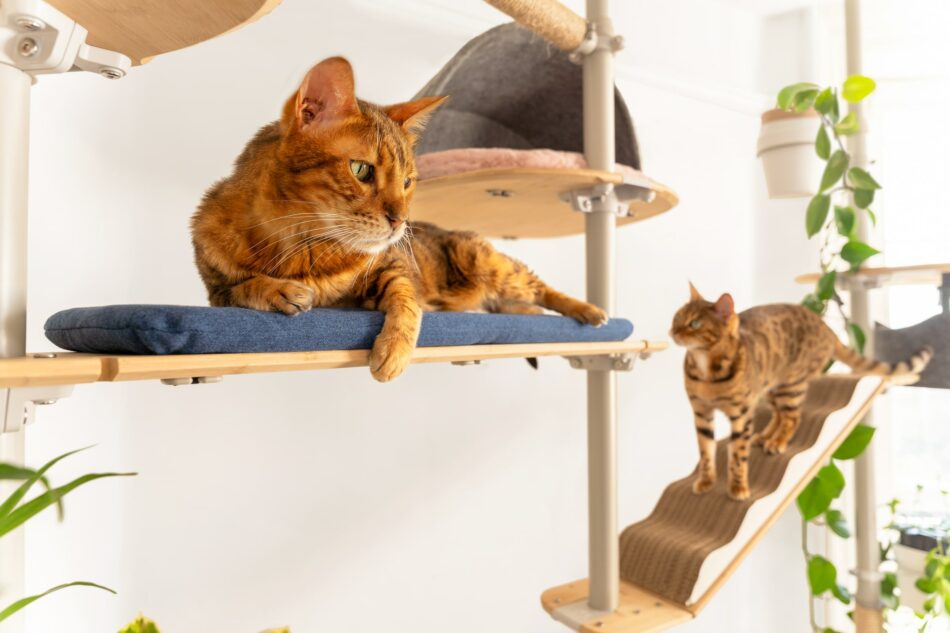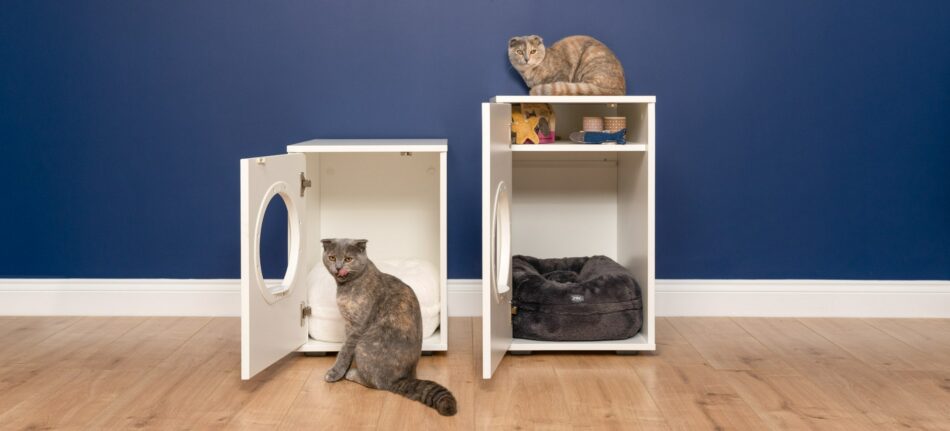How Do Cats Communicate With Each Other?
Have you ever wondered how your cat communicates with other cats? Do they speak in meows like they do with humans or do they have a special ‘cat only’ language?
Cat communication has evolved a lot over time. In the wild, the cat meow is a much lower, lingering sound than what we are used to. Fascinatingly, the beloved higher-frequency meows we hear are what cats learned through domestication to be more appealing and get what they want. As a result, domesticated cat’s meows are reserved mainly for us humans. When it comes to communicating with other felines, cats have several different ways they choose to ‘talk’. Let’s explore the many ways your cat communicates with other cats…
Talking cat-to-cat
Cats use the vocalization of meows or purrs to tell other cats (or you) what they want. With different pitches and intonations, they’re able to ‘speak’ their different physical or emotional needs. Here are a few examples of the types of sounds cats make and what they mean:
- Trilling-chirruping sounds – Cats will make this cat-specific sound when watching or stalking potential prey.
- Pleading, drawn-out “mee-owww” – This delightful sound is mostly reserved for us humans – it’s their way of saying “pay attention to me and give me a snuggle!”.
- Low growl: When a cat wants to be left alone, they will communicate with this low-level warning to tell another cat “back off” or “leave me alone”.
- Wailing hiss: You’ll know your cat is in distress or about to launch an attack when you hear the anxiety-ridden hiss sound.
A tale of cat tails
While using their voice is the way we most associate a cat’s ability to communicate, for everyday communication, cats actually prefer to use their body. More specifically, their tail. A cat’s tail acts as a flag waved on a stick. You can tell how they’re feeling and what they’re communicating when you better understand what each tail position means.
Let’s talk cat tails! If you see your cat’s tail upright in the air, this is usually a sign they’re feeling chilled out and friendly. And if they start gently swinging the upright tail back and forth, you can rest assured that your feline friend is super relaxed. They may even roll over on their snuggly cat bed for a belly rub and a snuggle.
On the other hand, if you notice your cat’s tail lashing back and forth in a quick motion this most likely means they are stalking something with intent. And if they start swishing their tail furiously this is your clue to check their surroundings as it can indicate the early stages of anger. Best to make sure you have a secluded sanctuary, like the Maya Cat House designed by Omlet for your cat to escape anytime they feel too much anxiety.
The eyes have it
It’s often said that in a cat’s eyes, all things belong to them. But did you know cats can actually communicate their mood with their eyes? Here are some common cat eyes to keep your eye on so you can better understand what they are saying:
- A hard stare: If you catch your cat in a stare off this usually means they’re locked in on a danger or prey. Their focused, unblinking eyes are a sign of dominance and usually a warning sign to other cats, or even cat toys, to be aware.
- A slow blink: Just like a wink is a sign of affection from your loved one, a slow blink from a cat means the same. It’s as if they are giving you kitty kisses with their eyes!
- Eyes wide open: Wide, alert cat eyes may seem to indicate something is wrong, but in actuality, this is a sign of trust. Often the big eyes are followed by a head butt to really drive home the trust factor, but all the same, it means your cat is in good company.
- Lazy squint: There’s really nothing better than a lazy eye cat squint. You know, the half-blink, half-asleep look you get when your kitty is getting cozy on their cat blanket. Next time you eye your cat giving you this look rest assured they are content, calm and happy.
Smelly messages
When it comes to cats, the nose knows. Scents are vitally important to cats and another way they communicate. In fact, cats use their scent glands to leave pheromone signals across their territory, both in the home and outside.
By using the scent glands on their cheeks, cats will rub your leg, the couch or even a fellow feline to literally spread their love. This is a form of affection, you could argue, but its main aim is to spread the pheromone messages. Cats also have scent glands where the tail joins the body, however, this is a less appealing region to be rubbed by!
Tom cats, or male domesticated cats, will often spray urine on things to ‘mark their territory’. Thankfully, this is typically an outdoor experience, however, it could become an inside issue if a strange cat has ventured into the building. Neutering usually brings an end to this macho, territorial habit.
Omlet can speak cat
Much of this communication behavior stems from the fact that cats are not pack animals. And so communicating with others is not a regular occurrence. At Omlet, we speak cat and we know all too well how much they need their personal space, only inviting others into it – feline or human – when they’re in the mood.
That’s why it’s important that you have a secluded spot for your cat to retreat to whenever they want so they can feel their best at all times. The Freestyle Indoor cat tree designed by Omlet is a perfect cat sanctuary as it allows your cat the ability to escape up high away from humans or other pets when they need that coveted alone time. Learn to recognize the feline’s vocal and body language, and you’ll soon be able to ‘speak cat’ yourself!
No comments yet - Leave a comment
This entry was posted in Cats on September 20th, 2019 by linnearask

